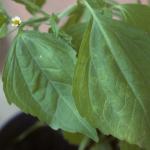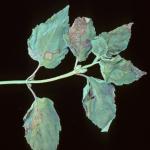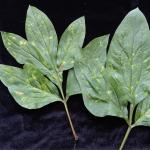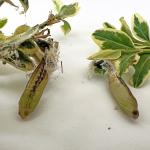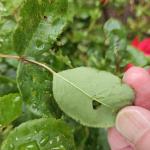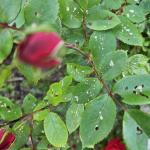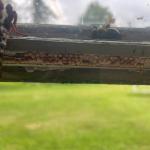A monthly e-newsletter from UMass Extension for landscapers, arborists, and other Green Industry professionals, including monthly tips for home gardeners.
Click on the headings below to jump to that section of the newsletter.
In This Issue
- I’ve come across ground nesting bees! What do I do?
- Viruses in Herbaceous Perennials
- Q&A - box tree moth, roseslugs, Cecropia moths
- Garden Clippings Tips of the Month
- Income, Equity and the Urban Forest: Strengthening Student Understanding in Springfield, MA
- Upcoming Events
To print this issue, either press CTRL/CMD + P or right click on the page and choose Print from the pop-up menu.
Hot Topics: I’ve come across ground nesting bees! What do I do?
 It’s officially summer, and that means many bee species are out and about! Most bees around the world nest in the soil, and the bee species documented in Massachusetts are no exception. While seeing bees nesting in the soil can be both a welcome and exciting sight, it may also be anxiety-inducing or stressful. Let’s go over some facts about bees, in addition to ways that the situation can be mitigated.
It’s officially summer, and that means many bee species are out and about! Most bees around the world nest in the soil, and the bee species documented in Massachusetts are no exception. While seeing bees nesting in the soil can be both a welcome and exciting sight, it may also be anxiety-inducing or stressful. Let’s go over some facts about bees, in addition to ways that the situation can be mitigated.
Part of the reason bees can induce fear is because many can sting. Did you know, though, that only female bees can sting? Stingers are a modified egg-laying device, so all male bees lack the ability to sting. Even though most female bees can sting, they are unlikely to be aggressive. Most bees are solitary and ground-nesting, which essentially means they keep to themselves! Solitary bees also have a much less venomous, less painful sting than their social counterparts (honey bees and bumble bees).
A common source of confusion is determining who is coming and going from the nest. Bees, wasps, and hornets are often lumped together, but the risk associated with having a nest nearby varies significantly among these groups. Most wasps carry minimal threat, especially because most wasp species are also solitary, but some social wasp species may be more aggressive. This includes yellow jackets. Hornets are a type of wasp, and all live in social colonies. In the case of yellow jacket or hornet nests, extermination strategies are sometimes the best option.
How can you tell the difference between a bee nest and a wasp or hornet nest? Generally speaking, bees are much furrier than wasps and have a more “robust” appearance. In the case of determining between a solitary bee nest and a wasp or hornet nest, sheer numbers will also do the trick. Multiple wasp and hornet individuals will frequently enter and leave the same nest entrance, whereas most solitary bee nest entrances will have a single female bee coming and going.
So, you’ve encountered a bee nest…what now? The best thing to do is to let them “bee”. You may choose to mark the location with small flags, so both you and others are aware of bees coming and going. This could be especially useful when children are around. Keep in mind, though, that a solitary bee is unlikely to sting (or even notice a human’s presence) unless you sit on it, or it gets stuck in your clothes.
You may be concerned about the presence of bees due to a serious allergy. In this case, you may choose to discourage soil-nesting bees by reducing the availability of bare patches of soil. Mulch, rocks, more plant cover, etc., could be added. This approach is only encouraged if you or someone frequently onsite has a serious allergy, as soil nesting habitat is pivotal for conserving bee species.
Key take-homes:
- Most bees in Massachusetts (and around the world) are both solitary and ground-nesting.
- Only female bees can sting – and they’re unlikely to do so unless stepped on, sat on, etc.
- Nesting sites are critical components of bee species conservation.
- Solitary bee ground nests can often be left alone; social wasp or hornet ground nests may warrant extermination.
- If you or someone frequently onsite has a serious allergy, the location of the nest can be marked. In addition, mulches or other materials can be added to reduce the suitability of the site for ground-nesting bees.
Nicole Bell, UMass Extension Pollinator Educator
Trouble Maker of the Month
Viruses in Herbaceous Perennials
Plant pathogenic viruses are traditionally named for the first plant they are observed in and the primary symptoms they cause. For example, tobacco mosaic virus was first seen in tobacco and often causes a mosaic pattern on the leaves. Most viruses have narrow host ranges but some affect a wide range of plant families; for instance, tobacco mosaic virus causes disease in numerous plant species from at least 19 different families. Most of the viruses commonly found in landscape perennials have broad host ranges.
There are several viruses that can affect herbaceous perennials in the landscape. Foliar symptoms may include mottling, mosaic, brown or yellow lesions, ringspots, streaks, wavy lines, yellowing of veins, and leaf deformities. Plants may also be stunted and/or lack vigor. Symptoms will vary among viruses and hosts. They can range from subtle to striking and their expression may be affected by environmental conditions. Some infected plants may show no symptoms at all.
Viruses typically do not survive in soil, but some viruses are transmitted by plant parasitic nematodes living in the soil or by insect pests such as aphids or thrips. Some may also be spread by mechanical means (that is, on the tools and hands of gardeners). Propagation of an infected mother plant will result in infected daughter plants.
There is no cure for plants infected with viruses. The primary management tactic is to remove infected plants and plant debris and dispose of everything in the trash. Disinfect tools frequently with 10% bleach or another antimicrobial solution. Wash your hands with hot water and soap. Use disease-free planting stock and inspect plants carefully for symptoms before bringing them into the garden or landscape. Avoid moving soil from the infested area into other areas. Manage weeds, which may also serve as hosts for viruses and organisms that may carry them. Although these precautions are recommended, don’t panic! Even if the virus has a wide host range, a garden-wide pandemic is extremely unlikely.
Angela Madeiras, UMass Extension Plant Pathologist
Q&A
Q. I don't know if you are keeping track of this pest or not, but I had people come into my local garden center with damaged boxwood. They lived in Sandwich, MA so when I got home (also Sandwich, MA) I looked at my plants and my variegated boxwood was filled with it.
A. The photos you’ve sent are box tree moth (Cydalima perspectalis) pupae! We are tracking this insect. Any box tree moth life stages or suspected damage to plants should be reported to the MA Department of Agricultural Resources (MDAR) using their Report Pest Sightings form.
Box tree moth populations currently exist in Bourne, Sandwich, and Barnstable, MA. The MA Dept. of Agricultural Resources (MDAR) provides a map of these locations on their Invasive Pest Dashboard. Locations outside of those known areas are especially important to report.
MDAR and the USDA APHIS recently announced a quarantine for the entire state of Massachusetts to restrict the movement of box tree moth, including boxwood plant parts, pieces, cuttings, clippings, debris, and any portion of the plant (alive or dead), except for decorative purposes, which are prohibited from movement outside of the state. To read the full announcement of the box tree moth quarantine for MA from MDAR, visit the Massachusetts Introduced Pests Outreach Blog.
UMass Extension also provides a fact sheet with information about monitoring and trapping box tree moth.
To read an educational blog post written by a UMass Extension stakeholder, visit this New Pest Alert for Cape Cod written by C.L. Fornari.
Q. I've been having the same issue with this double knockout rose shrub every year for the past several years. It starts out, as it is now, with loads of new flowers. Then, things deteriorate pretty fast. The foliage appears that it's being eaten by something and there are some spots on the leaves as well. A lot of canes have died each year. I've continued to cut the dead canes out. The plant struggles and doesn't do too well for the rest of the season. I've attached two photos that I took this afternoon. Hopefully, you can tell me what the issue most likely is and what I can do to alleviate the problem. Thanks so much!
A. The damage in your photos as well as the insect larva pictured are consistent with roseslugs, which typically are one of two species in New England: Endelomyia aethiops which is often called the roseslug and Allantus cinctus which may be called the curled rose sawfly. Both species develop into wasp-like adults (sawflies; Hymenoptera). As such, neither species can be managed with Bacillus thuringiensis Kurstaki (Btk) because that active ingredient is only effective on the Lepidoptera. Both species skeletonize the upper leaf surface of their host plants as they feed. Entire plants may be so damaged that they appear scorched by fire. The curled rose sawfly caterpillar also bores into the pith of host plant twigs, which can become an area where fungal pathogens may be introduced. Reduced risk active ingredients such as spinosad can help manage roseslugs, however this insecticide should not be applied to host plants in bloom. Old literature notes that syringing plants (spraying with a strong stream of water from a hose) every day or two may dislodge the sawfly larvae from their host plants (Chittenden, 1908). This may help to mechanically manage these insects in small plantings.
Q. Below is a photo of a cecropia moth that arrived at my sister’s farm-stand in VT on Saturday morning. We are wondering if it should be put outside. Also, the second photo is the same window and we are wondering if those are eggs. Can anyone give us some guidance on what to do with the moth and what the little brown things are?
A. The cecropia moth (Hyalophora cecropia) is one of the Saturniidae (giant silk moths) and is North America’s largest native moth. Cecropia moth adults do not feed and only live for approximately 2 weeks or less. These native moths should be preserved. An adult female trapped inside may be gently moved outdoors to allow it to search for additional locations to lay eggs. The “little brown things” below the window pictured here are eggs. Cecropia moth females lay approximately 100 white and brown mottled eggs. If they are laid singly in neat rows, the eggs are most likely viable. If the eggs have been laid in a pile or clump, they may not be. The eggs pictured here are likely to hatch in approximately two weeks or less, depending upon temperatures.
Cecropia moth eggs should not be moved when they are first laid. Allow 2-3 days for the chorion (the eggshell) to harden. The chorion is important to protect and provide waterproofing for the eggs. Once hardened, eggs laid in areas where host plants (black cherry and many others) are not available, can be scraped gently using a fingernail and placed in a plastic container. Once eggs hatch, young caterpillars can be “painted” onto host plant foliage using an artist’s paint brush (Don Adams, personal communication). For anyone looking for tips to raise any of the Saturniidae, there’s a great article by Don Adams available on the International Butterfly Breeders Association Ask A Mentor Archive. Note that predation and parasitism of cecropia moths is significant. Any help we can provide these beautiful giants goes a long way!
Tawny Simisky, UMass Extension Entomologist
Garden Clippings Tips of the Month
July is the month to . . . .
-
Water trees and shrubs. If there is less than ½ inch of rainfall during a week, make sure to water trees and shrubs planted within the last two years. Newly planted trees and shrubs should be watered regularly for two to three years, until their root systems become established. Water both around the trunk and the surrounding area. Water deeply, then let the water soak in to encourage new roots to grow deeper into the soil. Apply enough water to penetrate the soil to a depth of at least 10 to 14 inches once every two weeks. Plants in containers should be watered more frequently because there is little soil to hold water around the roots.
-
Water vegetable and flower gardens as needed. To reduce evaporation, water gardens in the morning. Water the soil and avoid watering the leaves to reduce fungal diseases. Water deeply and infrequently to encourage root growth.
-
Succession planting. To get a continuous supply of vegetables during the summer and fall, consider succession planting vegetables like beans, beets, lettuce, radish, and carrots. During fall you may need to use season extension methods to protect fall crops.
-
Keep weeding. Make sure to control weeds before they go to seed. If you catch them when they are still small, you can get decent control by using mechanical control methods such as pulling, hoeing, or cultivating. To minimize exposure to heat, try working in the morning after watering or in the evening. For difficult to control weeds such as yellow nutsedge, common blue violet and dandelion, you may need to use an herbicide. Make sure to select the right material for your weed species and to read and follow the directions on the label.
-
Harvest vegetables regularly. Regular harvests of vegetables from your garden encourage vegetable crops to keep producing until the fall. This is true for crops such as green beans, cucumbers, egg plants, green peppers, hot peppers, kale, Swiss chard, and tomatoes.
-
Water the lawn. Water frequently enough to prevent wilting, if preventing the onset of dormancy is a goal. Most turfgrasses require 1 to 1.5 inches of water per week for active growth. Early morning irrigation allows the turf to dry before nightfall, reducing the chance of disease. Water slowly so that water can enter the soil surface and avoid surface runoff or puddling. Avoid excessive irrigation that can cause soggy conditions which can intensify soil compaction.
-
Mow the lawn high. To reduce stress on turf, mow high and infrequently. 3-3.5 inches is a good target for most lawns to encourage shading of the soil surface, deeper rooting, and drought survival.
-
Monitor plants for spider mites. Spider mites can become a problem during hot, dry weather on ornamental plants, vegetables, and fruit crops. Spider mites can be difficult to see until populations get large and plants start showing symptoms of their feeding. If you suspect you have spider mites, closely inspect the undersides of leaves using magnifying lenses. Watch for very small mites that can range in color from yellowish or greenish to brown to orange red. Symptoms of mites’ damage include a speckled or mottled appearance on leaves and, as feeding continues, leaves may begin to yellow or bronze and eventually die.
-
Order spring flowering bulbs for fall planting. July is a good time to order for spring flowering bulbs like daffodils, Dutch iris, tulips, and hyacinths. Ordering early guarantees the best selection and ensures that you get all bulbs shipped to you in time for planting in the fall. Keep bulbs cool (50-65°F) before planting and keep them away from ripening fruit.
Geoffrey Njue, UMass Extension Sustainable Landscapes Specialist
Income, Equity and the Urban Forest: Strengthening Student Understanding in Springfield, MA
Since 2012, the University of Massachusetts (UMass) has been working in conjunction with the USDA Forest Service (USFS), the City of Springfield and ReGreen Springfield (a local NGO) to promote awareness and access to urban forests and community green spaces in Springfield, MA. Part of this collaboration has resulted in support for two successful summer scholar-intern candidates – one in 2015 and another in 2016 – as part of the ‘Connecting Students with Stakeholders’ program, administered by the UMass Urban Forestry Extension Program.
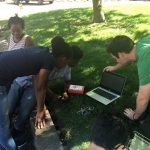 These individuals were highly motivated and passionate about working with, and leading other, volunteers and interns to improve the City of Springfield through environmental stewardship. They played a vital role in extending and augmenting urban forestry efforts through citizen-science initiatives, partnering with volunteers from environmental justice (EJ) communities to perform urban tree data collection, and restoration of parks and green spaces in their own neighborhoods. This included the Abbey Brook Watershed Monitoring Program, which was a key component of the Sustainable Springfield initiative. They also performed outreach to abutting neighbors, including working directly with school-aged students to develop a field–based classroom lesson plan relative to the exploration of urban forests, their affiliated benefits (i.e., runoff, CO2 sequestration), and the importance of urban green spaces.
These individuals were highly motivated and passionate about working with, and leading other, volunteers and interns to improve the City of Springfield through environmental stewardship. They played a vital role in extending and augmenting urban forestry efforts through citizen-science initiatives, partnering with volunteers from environmental justice (EJ) communities to perform urban tree data collection, and restoration of parks and green spaces in their own neighborhoods. This included the Abbey Brook Watershed Monitoring Program, which was a key component of the Sustainable Springfield initiative. They also performed outreach to abutting neighbors, including working directly with school-aged students to develop a field–based classroom lesson plan relative to the exploration of urban forests, their affiliated benefits (i.e., runoff, CO2 sequestration), and the importance of urban green spaces.
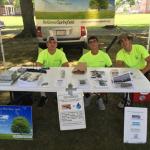 This experience led these two interns to consider the broader picture and look at what the research says about the dynamics of urban tree canopy cover and urban centers in other parts of the nation.
This experience led these two interns to consider the broader picture and look at what the research says about the dynamics of urban tree canopy cover and urban centers in other parts of the nation.
Urban centers and environmental equity
Cities are generally dynamic, vigorous landscapes and though often vibrant, their patchy, uneven character can sometimes lead to the inequitable distribution of environmental benefits and burdens. Findings from numerous research initiatives suggest that while there are a number of variables that are related to, and contribute to, the distribution of Urban Tree Canopy (UTC) cover, there is a strong, consistently positive correlation between UTC cover and median household income. This may be unsettling to a number of stakeholders, including the environmental justice (EJ) community that has long been concerned with patterns of low-income, and minority communities disproportionately being burdened by environmental hazards. In recent times, the scope of environmental equity has broadened from more of a singular focus on burdens, to include the distribution of environmental amenities like vegetation cover and access to parks and open spaces. It is generally reported (and accepted) that there is an uneven distribution of these environmental goods, disproportionate to members of racial and ethnic minority communities, and low-income neighborhoods. The National Center for Ecological Analysis and Synthesis (NCEAS) examined the potential inequities associated with the distribution of UTC cover in relationship to race/ethnicity and income, in seven cities across the U.S. – Baltimore, MD; Los Angeles, CA; New York, NY; Philadelphia, PA; Raleigh, NC; Sacramento, CA; and Washington, D.C. Both climate and tree canopy cover varied considerably from 55% in Raleigh to 13% in Philadelphia.
Urban tree canopy cover and income
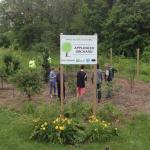 Though the initial expectation may be that all of the seven cities would clearly demonstrate that neighborhoods with lower-income, less education, and high percentages of people of color would have low UTC cover, this was not found to be consistent across cities that vary in climate and size, in addition to racial and ethnic composition. Consistent across all cities, however, was a positive relationship between UTC cover and median household income. In fact, most of the participating cities specifically availed that an increase of median household income by an estimated $1,000 could encourage a range of 0.05– 0.20 point (%) increase in UTC cover.
Though the initial expectation may be that all of the seven cities would clearly demonstrate that neighborhoods with lower-income, less education, and high percentages of people of color would have low UTC cover, this was not found to be consistent across cities that vary in climate and size, in addition to racial and ethnic composition. Consistent across all cities, however, was a positive relationship between UTC cover and median household income. In fact, most of the participating cities specifically availed that an increase of median household income by an estimated $1,000 could encourage a range of 0.05– 0.20 point (%) increase in UTC cover.
A distinguishing characteristic of the cities located in California was determined to be their arid climate. Trees planted in more arid climates receive substantially less natural rainfall and often require supplemental irrigation in order to survive. In temperate regions of the United States, trees can grow without additional watering on unmanaged, fallow or abandoned lands. Given the high water resource requirements in arid cities, the dominant role of income and resources in driving UTC cover may create a greater potential for environmental injustice in cities receiving little precipitation. Natural growth and regeneration of trees in cities with greater precipitation could obscure the effects of different levels of resources allocated towards growing and maintaining UTC cover. In these areas, an increase in UTC cover may be as a result of “disinvestment” – a condition where an area is permitted to return to its natural (potentially forested) state, as much as a result of intentional UTC cover increase through planned urban tree planting programs. Hence, treeless areas in arid climates may represent less investment in UTC cover and urban forest management, while in temperate areas, treeless areas may simply not be a reliable or accurate indicator of low investment.
The relationship between UTC cover and income may be the result of a type of cycle where high amounts of UTC cover increase property values and further attract households with high incomes. This positive feedback loop may support the continued maintenance of UTC cover in neighborhoods with high-income households and high levels of homeownership. Similarly, areas with low UTC cover have low property values, and residents may have less access to resources or incentive to increase property values because they are renters or on fixed incomes. For instance, it is possible that residents in low-income neighborhoods might reasonably resist increases in UTC cover to avoid gentrification and rising rents. The cost of tree maintenance, such as leaf clean-up, watering, and pruning, is another disincentive that can be particularly acute in low-income neighborhoods.
Urban tree planting and environmental justice
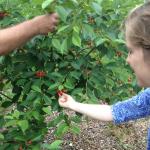 Increasing UTC cover has become a widespread goal, often incorporated into municipal sustainability plans. It has been proposed as a way to mitigate impacts from human-dominated systems on the immediate (e.g. shade and cooling) and global (e.g. carbon capture) environment. If the equity dimensions of sustainability are put into practice, UTC goals can help to rectify environmental injustices. However, it is important to note that tree planting initiatives are not a panacea for environmental justice, as trees can generate disservices, and in some cases costs may exceed local benefits or local desire and capacity to care for trees and other green infrastructure. Benefits from tree canopy cover might therefore be better assessed in using spatially-based strategies, since in some circumstances tree cover will provide strong positive services, while in others tree cover may provide negligible benefits or disservices associated with plant maintenance or clean-up.
Increasing UTC cover has become a widespread goal, often incorporated into municipal sustainability plans. It has been proposed as a way to mitigate impacts from human-dominated systems on the immediate (e.g. shade and cooling) and global (e.g. carbon capture) environment. If the equity dimensions of sustainability are put into practice, UTC goals can help to rectify environmental injustices. However, it is important to note that tree planting initiatives are not a panacea for environmental justice, as trees can generate disservices, and in some cases costs may exceed local benefits or local desire and capacity to care for trees and other green infrastructure. Benefits from tree canopy cover might therefore be better assessed in using spatially-based strategies, since in some circumstances tree cover will provide strong positive services, while in others tree cover may provide negligible benefits or disservices associated with plant maintenance or clean-up.
The association between income and tree canopy cover has important implications for urban sustainability plans, many of which include increased UTC cover as a goal. If UTC cover and income are positively reinforced (through property values, investments, or other mechanisms) any public or private interventions to increase tree canopies might first consider the needs of low income communities, provided that the economic and ecological benefits do not outweigh the costs and that there is local buy-in to the initiatives from local residents.
Moving Forward in Springfield
 Here in Massachusetts, the City of Springfield has been classified as a “Gateway City" by the MA Dept. of Conservation and Recreation due to its social, economic and ethic diversity considerations. It has a population of around 153,000 and is considered to be zone 6a by the USDA Plant Hardiness Zone Map. As a result of the cooperative efforts of the aforementioned organizations, 3000 new street trees have been installed over the past 5 years. Providing student scholars with the opportunity to work in this diverse environment with other like-minded professionals and community stakeholders, has been a unique experience that offers the potential to not only enrich an individual’s summer employment experience, but to also shape and impact lifelong career decisions in urban forestry and urban natural resources awareness and conservation.
Here in Massachusetts, the City of Springfield has been classified as a “Gateway City" by the MA Dept. of Conservation and Recreation due to its social, economic and ethic diversity considerations. It has a population of around 153,000 and is considered to be zone 6a by the USDA Plant Hardiness Zone Map. As a result of the cooperative efforts of the aforementioned organizations, 3000 new street trees have been installed over the past 5 years. Providing student scholars with the opportunity to work in this diverse environment with other like-minded professionals and community stakeholders, has been a unique experience that offers the potential to not only enrich an individual’s summer employment experience, but to also shape and impact lifelong career decisions in urban forestry and urban natural resources awareness and conservation.
The authors would like to thank Domenic Savoie, Lauren Bullard and all of the summer interns and volunteers who tirelessly advocate for street trees and green spaces in the City of Springfield, MA.
Rick W. Harper, Ph.D., University of Massachusetts and David V. Bloniarz, Ph.D., USDA Forest Service
Upcoming Events
For upcoming educational prgrams, go to the UMass Extension Landscape, Nursery, and Urban Forestry Program Upcoming Events Page.
Additional Resources
For detailed reports on growing conditions and pest activity – Check out the Landscape Message
For professional turf managers - Check out our Turf Management Updates
For commercial growers of greenhouse crops and flowers - Check out the New England Greenhouse Update website
For home gardeners and garden retailers - Check out our home lawn and garden resources
TickTalk webinars - To view recordings of past webinars in this series, go to: https://ag.umass.edu/landscape/education-events/ticktalk-with-tickreport-webinars
Diagnostic Services
Landscape and Turf Problem Diagnostics - The UMass Plant Diagnostic Lab is accepting plant disease, insect pest and invasive plant/weed samples. By mail is preferred, but clients who would like to hand-deliver samples may do so by leaving them in the bin marked "Diagnostic Lab Samples" near the back door of French Hall. The lab serves commercial landscape contractors, turf managers, arborists, nurseries and other green industry professionals. It provides woody plant and turf disease analysis, woody plant and turf insect identification, turfgrass identification, weed identification, and offers a report of pest management strategies that are research based, economically sound and environmentally appropriate for the situation. Accurate diagnosis for a turf or landscape problem can often eliminate or reduce the need for pesticide use. See our website for instructions on sample submission and for a sample submission form at http://ag.umass.edu/diagnostics.
Soil and Plant Nutrient Testing - The lab is accepting orders for Routine Soil Analysis (including optional Organic Matter, Soluble Salts, and Nitrate testing), Particle Size Analysis, Pre-Sidedress Nitrate (PSNT), Total Sorbed Metals, and Soilless Media (no other types of soil analyses available at this time). Testing services are available to all. The lab provides test results and recommendations that lead to the wise and economical use of soils and soil amendments. For updates and order forms, visit the UMass Soil and Plant Nutrient Testing Laboratory web site.
Tick Testing - The UMass Center for Agriculture, Food, and the Environment provides a list of potential tick identification and testing options at: https://ag.umass.edu/resources/tick-testing-resources.
